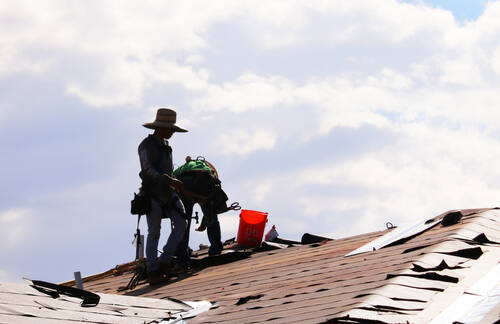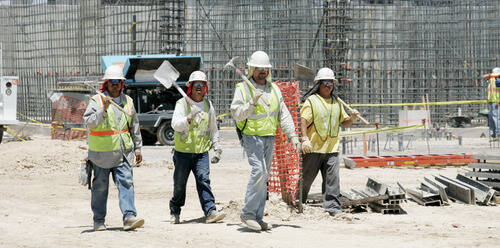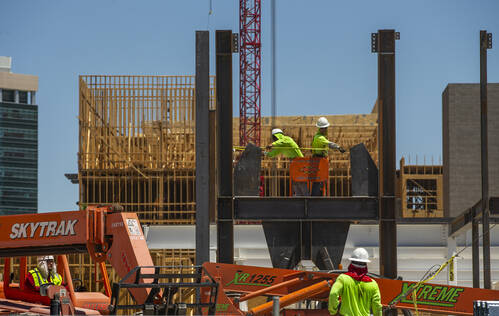Nevada workers at risk for heat illness get new protections
A new program to protect employees from heat exposure and illness begins, as heat complaints increase and Southern Nevada experiences extreme temperatures.
The Nevada Occupational Safety and Health Administration is implementing a National Emphasis Program to safeguard workers in outdoor and indoor settings, modified for the state’s hot and dry climate.
This new program stems from concerns that warming temperatures might be causing unsafe working conditions. A recent study from the Desert Research Institute led by Dr. Erick Bandala, assistant research professor of environmental science, found that average summer heat index values increased between 2011 and 2018.
With rising temperatures, the study found that reported heat-related worker injuries in Nevada rose during the same time period.
“We need to do something to protect workers,” Bandala said, “because honestly, it’s not going to get any better.”
When the National Weather Service issues a heat warning or advisory, Nevada OSHA will conduct inspections in more than 70 high-risk industries including construction, manufacturing and resorts. Many of the industries are already on a targeted list for comprehensive inspections, but during the National Emphasis Program, heat will be added as an inspection component.
Also, on heat priority days on which the heat index is expected to exceed 90 degrees, OSHA will be able to launch partial inspections in response to heat-related complaints, regardless of industry. In the past, the agency primarily sent letters of inquiry to employers to address those complaints.
While federal OSHA uses 80 degrees as the heat priority threshold, Nevada OSHA considers 90 degrees more appropriate for the state’s dry climate.
From 2016 to 2021, Nevada OSHA received 547 heat stress complaints in Southern Nevada. Across the state, there have been at least seven worker fatalities potentially linked to heat during the same period of time. But because illnesses, injuries and fatalities from heat exposure are often underreported, those numbers may be much higher.
“Sometimes people don’t realize heat might be the reason for an illness or injury,” Victoria Carreón, administrator at the Nevada Department of Business and Industry, Division of Industrial Relations, said. “Maybe a worker had a fall, but that happened because the worker was impaired due to the heat.”
Often, Carreón said, if a worker has a pre-existing medical condition, the heat might be overlooked as a contributing factor when filing a report.
During inspections, representatives will evaluate general workplace conditions. They’ll also examine on-site temperatures, whether the workplace’s safety program includes provisions for managing heat illness and if employees are provided with proper clothes to protect them from the heat. While each inspection will be different, OSHA can enforce penalties on the business if an inspector uncovers any serious hazards related to heat exposure.
Regulations may be on the way
Nevada doesn’t have an enforceable heat illness standard for workers, but that may change in the near future. Nevada OSHA is working with stakeholders to develop a regulation that would allow the agency to enforce penalties on employers under a clause specific to heat.
This regulation would require businesses with workers exposed to temperature conditions above 90 degrees to have a program for managing heat illness, such as providing access to shade and potable water and monitoring employees for signs of illness.
These businesses would also be required to provide workers with training about working in the heat and include information about heat exposure in their workplace safety program.
Carreón said the regulation will make it easier for both businesses and the state to determine what it means to be compliant.
Dale Walsh, certified industrial hygienist, said most of the new regulations are “common sense.” He said he thinks that high-risk industries such as construction and manufacturing shouldn’t be affected too much by the regulation.
“In most places, if you get more education going and provide resources for staying cool and hydrated, that’s going to meet the regulation,” he added.
Jorge Macias, corporate director of safety at Martin-Harris Construction, isn’t too worried either. The company already provides items such as ice water, cooling towels, shade and annual training to employees. Macias said most of the regulation’s requirements “are things we should be doing for our employees already.”
Carreón said the best things employers can do to prepare for the National Emphasis Program and proposed regulation is to put something into their safety program regarding heat, and train workers about how to prevent heat illnesses. Employers should provide cool water and shady recovery areas for employees.
If businesses need help preparing, the Nevada Safety Consulting and Training Section (SCATS) provides free, confidential aid to employers to help design their training and create a safe working environment.
At the end of the day, Carreón said, “we want to keep our fellow workers as safe as possible from the heat, especially during summer months.”
Colton Poore is a 2022 Mass Media reporting fellow through the American Association for the Advancement of Science. Email him at cpoore@reviewjournal.com or follow him on Twitter @coltonlpoore
Signs of illness
Anyone experiencing symptoms of heat-related illness should immediately seek a cool, shaded area, drink plenty of water and attempt to cool the body as much as possible. If a person's condition worsens or they display symptoms of heat stroke, call 911 right away.
Common signs of heat exhaustion:
Excessive sweating
Cool, pale, clammy skin
Feeling faint or dizzy
Nausea
Muscle cramps
Common signs of heat stroke:
No sweating
Hot, dry skin
Throbbing headache
Nausea
Loss of consciousness or fainting



















